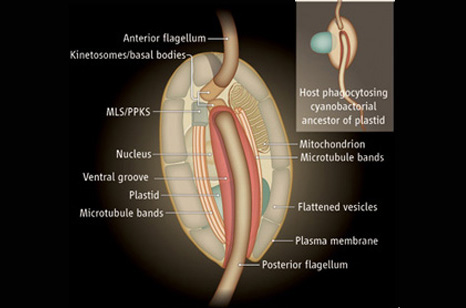
FAYETTEVILLE, Ark. – A University of Arkansas biologist has created a sketch of what the first common ancestor of plants and algae may have looked like. The image appears as part of a “Perspective” article in the Feb. 17 issue of Science. The image is based on a research paper that is also published in this issue of Science.
Fred Spiegel, professor of biological sciences in the J. William Fulbright College of Arts and Sciences, suggests what microscopic parts would have been present in this common ancestor based on findings by Dana Price of Rutgers University and his colleagues, who examined the genome of a freshwater microscopic algae and determined that it showed that algae and plants are derived from one common ancestor. This ancestor formed from a merger between some protozoan-like host and cyanobacterium, a kind of bacteria that use photosynthesis to make energy, that “moved in” and became the chloroplast of this first alga. Price and his colleagues show that today’s algae and plants have to be descended from this first alga, but they give no idea what it looked like.
“The work that Price and his group did nailed down what the relationships are” between this organism, the algae and plants, and all other eukaryotes, organisms that have a true nucleus in their cells, Spiegel said. “Once you know that, you can compare the structure of cells and characteristics you see in algae and plants with other eukaryotes and get a reasonable idea of what the original critter must have looked like.”
For many years, scientists have speculated that the original ancestor of plants and algae must have originated from a protozoan-like organism and cyanobacteria. They theorized that at some point in the distant past the cyanobacteria became part of the other organism and created the first alga, which in turn created the opportunity for the growth into the biodiversity found in plants that we see today.
However, other scientists argued that the diversity and complexity of plants and algae suggest multiple events where different organisms merged. They pointed out that some members of the plant kingdom have simple structures and therefore must be more primitive than others.
Price and his colleagues’ studied the genome of an obscure alga called Cyanophora. Their results strongly suggest that the first alga arose about a billion to a billion and a half years ago. This alga became the ancestor to the group of algae containing Cyanophora, plus the group of algae that includes the red seaweeds, plus the group that includes the green algae and the land plants. Together, these organisms form the super group called Plantae.
Based on this research, Spiegel has put forth a hypothetical snapshot of what the common ancestor of Plantae, the “first alga,” might have looked like.
“The common ancestor of Plantae was an organism with very complex cells and a complex life cycle,” Spiegel said. While some members of the super group Plantae may have less complex cells and life cycles, this does not mean they pre-date the common ancestor. “They’re simpler because they lost parts, not because they originated that way.”
Contacts
Fred Spiegel, professor and chair, biological sciences
J. William Fulbright College of Arts and Sciences
479-575-4248, fspiegel@uark.edu
Melissa Blouin, director of science and research communication
University Relations
479-575-3033,
blouin@uark.edu